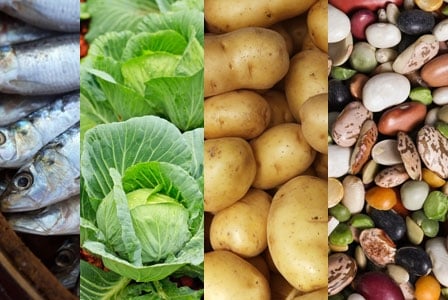
In our third Superfood Spotlight installation, were switching gears a bit to talk about five underappreciated superfoods.
In our third Superfood Spotlight installation, we’re switching gears a bit to talk about five underappreciated superfoods. While goji berries, quinoa, and cacao nibs are all the rage right now, many foods, though super in their nutrition profile, are simply not getting the attention they deserve.
Prunes
Unfortunately, prunes don’t have the most glamorous reputation, often being associated with nursing homes and constipation. However, it’s time we look at prunes in a more flattering light and praise them for the superfood they are.
The high insoluble fibre content in prunes is what makes them an excellent laxative; however, it’s their high soluble fibre content that makes them a great addition to a balanced diet. See, a diet high in soluble fibre has been shown to reduce mortality rates of cardiovascular disease. Further, prunes contain potassium, which may lower blood pressure; boron, which may help with osteoporosis; and carotenoids, which fight free radicals and help prevent disease.
Eat prunes on their own or try them in this Spiced Israeli Couscous with Prunes and Ginger recipe.
Sardines
Available smoked, canned, or frozen year-round or fresh in late summer, sardines are an easy (and sustainable) addition to a variety of dishes when you want a bit of added oomph.
Sardines are particularly high in omega fatty acids, especially omega-3s, which have been shown to support heart health, skin health, and weight loss, as well as help ease symptoms of depression. They’re also a good source of calcium, iron, selenium, phosphorus, vitamin D, and vitamin B12.
Give sardines a chance with this tasty Sardine Sandwich with Walnut Spread.
Cabbage
Bland, boiled to oblivion, and terribly stinky is probably how many people perceive cabbage. However, when cooked with care, cabbage can be a delicious side dish boasting superfood qualities.
Despite its less than stunning aesthetics, cabbage is one of the healthiest things you can eat. It’s extremely filling, but contains very few calories—just 16 per cup serving of shredded cabbage. And although we’re told to seek out brightly coloured fruits and veggies, this monochromatic veggie is actually loaded with vitamin C—the same one cup serving contains nearly 50 percent of our daily recommended intake of vitamin C. Further, it’s part of the cruciferous family of vegetables, which have been shown to be crucial in cancer prevention.
Enjoy cabbage in one of these delicious dishes.
- Braised Cabbage and Beets
- Cabbage and Potato Curry
- Tofu Cabbage Rolls
- Outrageous Red Cabbage Stir-Fry with Pinto Beans
Potatoes
For centuries the potato was considered to be a hearty and nutritious staple. However, with the anti-carb craze still in full force, the lowly potato has been cast aside for other “healthier” options on our dinner plates.
Fact: potatoes are high in antioxidants. That’s right, in a recent study researchers tested 100 common foods and ranked them based on antioxidant content. Surprisingly to many, potatoes ranked fifth. In addition, potatoes contain fair amounts of vitamin B6, thiamine, riboflavin, folate, magnesium, phosphorus, iron, and zinc. But in addition to antioxidants, they pack a real nutritional punch when it comes to supplying potassium, vitamin C, and resistant starch (a type of dietary fibre).
Give spuds another shot with these mouthwatering recipes.
- Spicy Oven Fries
- Jeera Alu: Potatoes Fried with Cumin
- Dijon-Laced Mashed Potatoes and Parsnip
- Lentil Potato Dal with Cashew Almond Sauce
Pulses
Beans, peas, lentils, and chickpeas, also known as pulses, are often neglected in the diets of Canadians, and it is unfortunate, as they offer tremendous health and nutrition benefits.
Pulses are an excellent source of fibre, both soluble and insoluble, which can help lower blood cholesterol levels while also maintaining bowel health. Further, they’re low in fat with no trans fat and are a low-glycemic index foods, which means they release sugar into the blood system slowly, an attribute beneficial to those needing to regulate their blood glucose levels.
Try one of these bean-tastic recipes tonight!
- White Bean Dip
- Three Bean Salad
- White Bean Kale Soup
- Vegetarian Molasses Baked Beans

